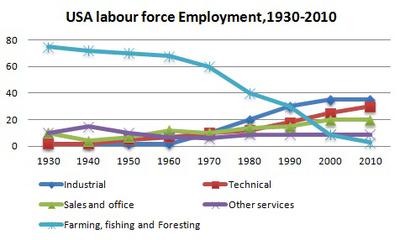IELTS Line Graph - Employment Patterns in the USA
by Hura
(Hanoi, Viet Nam)

USA labour inforcement
Hello everyone!
I have to say that: this has been the first time i try writing an IELTS writing task 1. I am sure that I have made a lot of mistake. However, I still write it down here. Can you and other readers help me incorrect and improve it? Thank you so much!
Here is my paragraph (I tried it in about 25 minutes)
Answer
The given graph illustrates the employment patterns over a 70 year timescale in the USA.
In 1930, the USA labor force concentrated on farming,fishing and foresting, while the employment of industry, sales and offices, technology and other services were at such a low percentage. However, through 70 years, the number of employee in farming, fishing and foresting decreased dramatically in contrast of sales and offices, industrial and technical ones.
There was over 75% labor force in farming, fishing and foresting in 1930. But it started to drop down gradually until 1970 and significantly went on dropping and got only approximately 3% in 2010. It was a more than 70% dropped over 70 years.Also other services labor, nevertheless, this patterns slightly decreased about 5% over the exact time length.
On the contrary, sales and offices as well as technical and industrial employee number increased slightly from 1930 to 170.Although later developing, Industrial labor also achieved the same proportion with the above two patterns at around 12%. All this three patterns witnessed a robust rise from 1970 to 2010. Whereas sales and offices percentage increased about 8%,that of industry and technology rapidly accelerated and get similarly around 35%. It was approximately 25% raised percentage in overall for these two patterns.
Band 7+ eBooks
"I think these eBooks are FANTASTIC!!! I know that's not academic language, but it's the truth!"
Linda, from Italy, Scored Band 7.5












